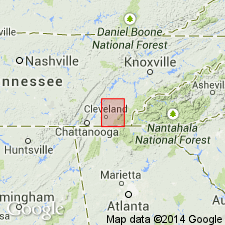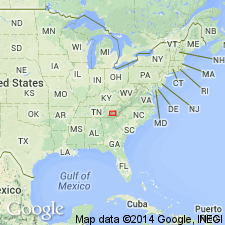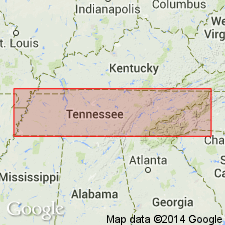
- Usage in publication:
-
- Thunderhead conglomerate*
- Modifications:
-
- Revised
- AAPG geologic province:
-
- Appalachian basin
Summary:
Thunderhead conglomerate [of Chilhowee group]. Applied Thunderhead to 3 formations (descending): Thunderhead conglomerate, 300+/- feet; Thunderhead slate, 1,500+/- feet; Thunderhead conglomerate, 800 to 1,000 feet; the latter formation resting conformably on Pigeon slate. [Age is Early Cambrian.]
Source: US geologic names lexicon (USGS Bull. 896, p. 2145).

- Usage in publication:
-
- Thunderhead conglomerate*
- Modifications:
-
- Original reference
- Dominant lithology:
-
- Conglomerate
- Graywacke
- Sandstone
- Slate
- AAPG geologic province:
-
- Appalachian basin
- Piedmont-Blue Ridge province
Summary:
Pg. 2. Thunderhead conglomerate. Heavy series of conglomerate, graywacke, and sandstone, with many small partings of slate. General color gray. Slate beds black or dark gray when fresh. Thickness believed to be 3,000 feet. Little variety in formation and no division into beds of distinct character. The coarse beds vary only in proportion of quartz and feldspar. All slate beds are same in composition. Overlies Cades conglomerate and underlies Hazel slate. [This is type area of formation.]
[Named from development on Thunder Head [Thunderhead Mountain], western Great Smoky Mountains, Blount Co., eastern TN, and Swain Co., western NC.]
Source: US geologic names lexicon (USGS Bull. 896, p. 2145).

- Usage in publication:
-
- Thunderhead sandstone*
- Modifications:
-
- Revised
- Age modified
- AAPG geologic province:
-
- Appalachian basin
- Piedmont-Blue Ridge province
Summary:
Pg. 958-959. Redescribed as Thunderhead sandstone. Reallocated to Great Smoky group. Thickness about 8,0.00 feet near Thunderhead Mountain; 6,000 feet on Mount Le Conte, and more than 10,000 feet in northeastern part of mountains. These thicknesses are not of wholly contemporaneous beds because span of formation becomes progressively higher eastward; lower part in west is equivalent to Elkmont sandstone (new) farther east, and upper part in east is equivalent to Anakeesta formation (new) farther west. Type Clingman is probably equivalent to upper beds of Thunderhead sandstone. [Age is Precambrian (Ocoee).]
[Thunderhead Mountain is in more remote part of region; formation is better exposed on Mount Le Conte farther east where full section is present.]
Source: US geologic names lexicon (USGS Bull. 1200, p. 3879).

- Usage in publication:
-
- Thunderhead Sandstone
- Modifications:
-
- Areal extent
- AAPG geologic province:
-
- Appalachian basin
Summary:
Used as Thunderhead Sandstone of Great Smoky Group in Unaka Mountains. Age is Precambrian.
Source: GNU records (USGS DDS-6; Reston GNULEX).
For more information, please contact Nancy Stamm, Geologic Names Committee Secretary.
Asterisk (*) indicates published by U.S. Geological Survey authors.
"No current usage" (†) implies that a name has been abandoned or has fallen into disuse. Former usage and, if known, replacement name given in parentheses ( ).
Slash (/) indicates name conflicts with nomenclatural guidelines (CSN, 1933; ACSN, 1961, 1970; NACSN, 1983, 2005, 2021). May be explained within brackets ([ ]).

